Traditional Filipino music theory is not a single, unified system. Instead, it is a dynamic blend of different influences. Indigenous practices, such as the use of the kulintang, a traditional gong instrument, are an essential part of this blend. The impact of Spanish colonialism is also evident in genres like the kundiman, a type of romantic ballad. American influence further shaped the landscape by introducing Western musical styles. As a result, modern Filipino music retains traditional elements while incorporating contemporary sounds and production techniques.
This interplay of diverse elements has created a rich and complex musical history. The evolution of sounds and forms is fascinating, with traditional instruments and styles blending with modern influences. For example, the kulintang is often paired with modern electronic beats, creating a unique sound that is both traditional and contemporary. This blend of old and new has resulted in a vibrant and diverse musical landscape that continues to evolve today.
A History of Filipino Music

Filipino Music's Cultural Heritage****
Filipino music has a rich history shaped by diverse cultural influences. The Spanish colonial period introduced Western musical forms**, which blended with existing traditions to create unique genres. For instance, the zarzuela became a powerful tool for expressing nationalistic sentiments**, as seen in the adaptation of Spanish and Mexican dances into Filipino Folk Dance, reflecting the era's cultural identity.
Oral Traditions and Classical Music****
Oral traditions played a crucial role in preserving musical heritage across generations. Classical music thrived among the elite, showcasing the cultural sophistication of the Filipino people during this period.
American Influence and Musical Festivals****
The American occupation brought jazz, blues, and rock and roll, leading to the birth of Philippine rock and roll. Musical festivals and regional variations emerged as Filipino musicians experimented with these new influences, developing unique styles.
Manila Sound and Cultural Identity
The 1970s saw the rise of Manila Sound, a distinctly Filipino genre that showcased contemporary collaborations between musicians. This era also marked the growing use of Tagalog, strengthening the connection between music and cultural identity.
Original Pilipino Music (OPM) and Politics
The development of OPM saw the rise of politically charged songs, highlighting music and politics. Artists expressed social commentary, reflecting the changing times.
Diversification and Industry Evolution
The 1980s and 1990s brought further diversification, with Pinoy pop and rock becoming increasingly prominent. OPM organizations were established to protect artist rights, and debates surrounding gender roles in the music industry continue to this day.
Contemporary Filipino Music****
Contemporary Filipino music continues to evolve, representing a vibrant tapestry of influences and innovations.
Indigenous Musical Traditions
Indigenous Musical Traditions Preserve Cultural Identity****
Rich Cultural Heritage
Beyond external influences, indigenous musical traditions in the Philippines possess a unique richness. The kulintang, a gong chime, is central to Maguindanaon and Maranao culture, while the gangsà, flat gongs, are unique to the Cordillera.
Other instruments, such as bossed gongs, kutiyapi, babarak, and aroding, represent diverse regional styles, each with its specialized players. These instruments are integral to community engagement, rather than just being tools.
Music in Community Life
Music plays a vital role in community life, accompanying life events from birth to death and integrating seamlessly into daily activities.
Music is used in healing and conflict resolution**, highlighting its symbolic power. This music reflects ancient wisdom and beliefs, deeply rooted in spirituality and nature. Musical symbolism** conveys meaning beyond the sounds themselves.
Regional Variations and Cultural Significance****
Regional variations are significant, reflecting cultural cross-breeding and influences from Southeast Asia and beyond.
The pre-colonial origins of some instruments, like the kulintang, point to historical connections. Transmission typically occurs orally, emphasizing hands-on learning within the community.
Modern preservation efforts and innovative fusions with contemporary genres aim to safeguard these traditions while fostering cultural resistance and maintaining Indigenous identity.
Forms in Filipino Music
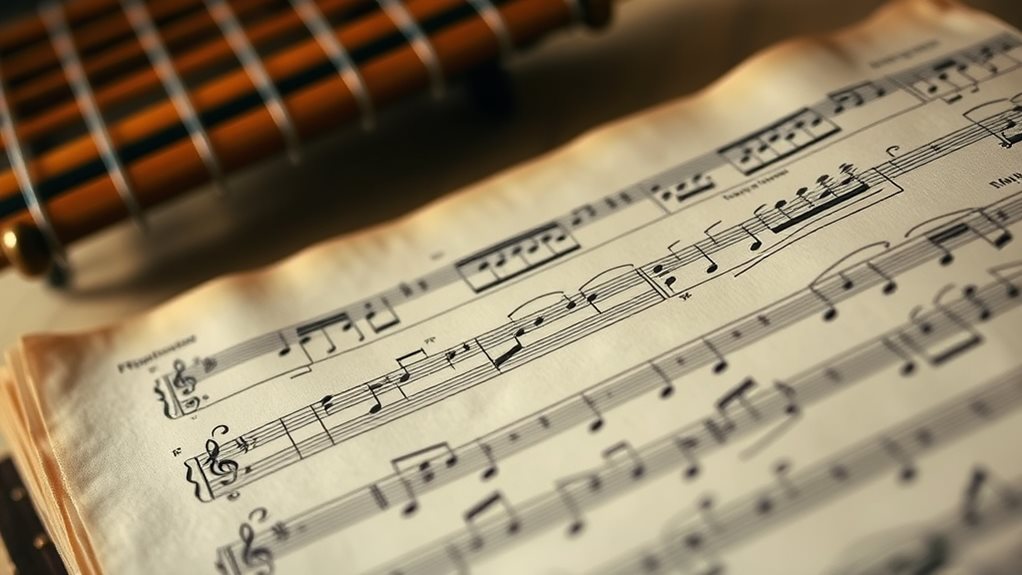
Filipino Music: A Reflection of Cultural Identity****
Filipino music is deeply rooted in the country's cultural identity, with diverse forms reflecting its rich heritage.
Regional styles and cultural expressions shape these forms, which are characterized by vibrant dance rhythms, unique instrument variations, and distinct vocal techniques.
Forms of Filipino Music****
Southern Styles are characterized by the use of kulintang, agung, and other metallic percussion instruments.
Kulintang music is a prime example, showcasing the region's distinct sound.
Northern Styles feature flat gongs, with unique playing techniques like pattong and toppaya.
Cordillera gong music is a notable example, highlighting the region's distinct sound.
Dance Music includes forms like Balitao, Cariñosa, and Tinikling, which have distinctive rhythms and accompanying music.
These dance forms reflect regional styles and storytelling.
Vocal Music encompasses forms like Harana, Kundiman, and Pasyon chants, which vary across regions.
Vocal techniques are influenced by Spanish and indigenous practices, resulting in unique regional styles.
Ensemble Performance is a hallmark of Filipino music, with kulintang ensembles being a prime example.
These ensembles showcase complex, often improvisational, interplay between gongs and other instruments.
Regional Differences
Regional differences are pronounced in Filipino music, resulting in unique instrument variations and vocal techniques.
These differences contribute to the richness and complexity of the country's cultural heritage.
The Kutiyapi and Basal
The Kutiyapi: A Unique Stringed Instrument****
The kutiyapi is a significant stringed instrument in the Philippine archipelago, representing a distinct tradition. It's crafted from a single piece of wood, often jackfruit, with a slender body, curved neck, and small resonating chamber.
It has two strings, one a drone and the other a melody an octave higher, which are fretted with beeswax. Traditionally, it's played with a rattan plectrum, now often replaced with plastic. The kutiyapi holds cultural significance for various groups, including the Maguindanao, Maranao, and Manobo, and is used in ceremonies, rituals, and storytelling, sometimes accompanying dances or epic chants.
The Kutiyapi's Role in Ensembles and Cultural Identity****
The kutiyapi is integral to the cultural identity of various groups and plays a vital role in ensembles like the kasingkil. Despite its importance, its presence is dwindling in some regions, highlighting the need for preservation efforts.
The Basal: An Elusive Instrument
The basal is an instrument with little to no documented information regarding its construction, cultural context, musical role, or modern status. This lack of information poses a challenge for researchers, leaving its history and musical contribution largely unknown.
Further research is needed to determine its place within Filipino musical heritage. The contrast between the well-documented kutiyapi and the elusive basal highlights both the depth of knowledge available for some instruments and the areas requiring further investigation within Filipino musical traditions.
Spanish Colonial Influences

The Spanish colonization of the Philippines in the 16th century significantly altered the country's musical landscape.
The introduction of Spanish instruments, such as the harp, guitar, and bandurria, reshaped musical practices. By the mid-1700s, the harp had become extremely popular in Manila, often accompanying church vocal music.
Religious music became a tool for evangelization, with the introduction of Spanish liturgical music, including Gregorian chant and motets.
The imposed Spanish musical practices fostered both compliance and musical resistance. The Spanish Crown used music as a tool for social control, establishing loyalty through imposed musical practices.
However, indigenous traditions didn't disappear. Music syncretism emerged, blending Hispanic influences with pre-existing forms. The rondalla, a popular ensemble featuring the bandurria, exemplifies this fusion.
Oral transmission helped preserve indigenous traditions, which were integrated into new musical practices, reflecting geographical variations. The Manila galleons further facilitated global transculturation, enriching the musical landscape.
This music syncretism created a unique musical legacy, reflected in modern Filipino musical styles and festival music, shaping Philippine national identity. The Spanish colonial influence continues to resonate in contemporary performance traditions.
Metrical Romances and Subli
Philippine music was shaped by Spanish colonial influence, but unique forms emerged that blended cultures. Metrical romances, narrative poems or songs introduced during the Spanish period, were adapted by local artists and woven into Philippine folk music. Sung in various vernacular languages, they reflect the archipelago's linguistic diversity and maintain a strong oral tradition, crucial for cultural preservation.
Metrical romances told stories of local heroes and mythical events, showcasing cultural exchange and synthesis. They served social functions, appearing in celebrations and gatherings, and aided in the dissemination of Christian ideals, influencing later musical forms and preserving historical narratives and myths.
The Subli, originating in Batangas, is a syncretic dance and music form that combines pre-colonial and Catholic traditions. It features intricate footwork and hand movements, often seen in religious celebrations, and requires community participation, with dancers and musicians working collaboratively.
The Subli showcases a blend of indigenous and Western musical elements, highlighting the cultural hybridity of the Philippines. Its structured steps and formations, passed down through generations, ensure cultural preservation of this unique art form. The music, often played on traditional instruments, blends with chanting and singing, enriching the performance's appeal.
Harana and Kundiman
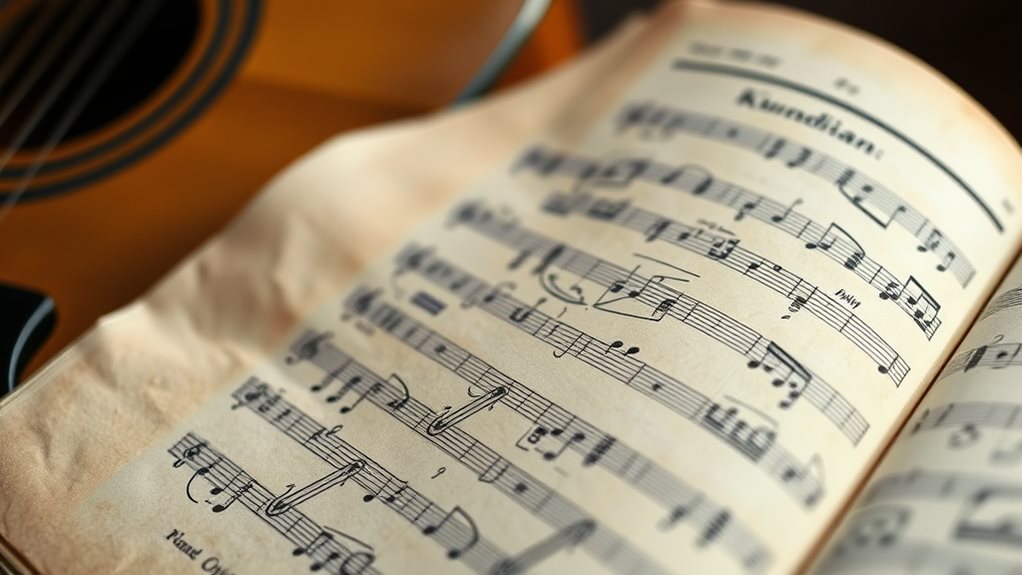
Romantic Expression in the Philippines****
Romantic expression in the Philippines finds rich articulation in the harana and kundiman, two distinct musical forms that reflect the country's diverse cultural heritage.
Harana: A Traditional Courtship Serenade****
The harana, a courtship serenade, traditionally features a 2/4 habanera rhythm and archaic Tagalog lyrics. Its significance lies in its role as a traditional method of wooing****, often involving a staged sequence from calling out to final farewell.
Kundiman: A Musical Form of Heartbreak and Unrequited Love****
In contrast, the kundiman, while also using archaic Tagalog, typically employs a 3/4 time signature and often focuses on themes of heartbreak and unrequited love. Its evolution reflects a blend of pre-colonial influences and later adaptations.
Key Differences and Shared Elements
You'll notice key differences in their musical structure and lyrical content. The harana prioritizes the act of serenading, employing a specific rhythm to enhance the dramatic effect, whereas The kundiman prioritizes the expression of complex emotions****.
Both forms, however, share a deep connection to traditional Filipino culture.
Shared Elements
- The guitar is central to both forms.
- Both utilize archaic Tagalog, showcasing linguistic richness.
- Both reflect traditional gender roles and courtship norms.
- Modern reinterpretations blend traditional elements with contemporary styles.
Cultural Significance
Understanding the harana and kundiman provides insight into the evolution of Filipino musical expression and its role in shaping cultural identity and romantic customs.
You can observe the subtle interplay between musical form and social context within these beloved genres, further highlighting their profound cultural significance.
Evolution of Rondalla
Rondalla: A Blend of Indigenous and Spanish Musical Influences****
The rondalla, a vibrant Filipino musical ensemble, originated during the Spanish colonial period as a fusion of indigenous styles and Spanish musical influences. The term "rondalla" means "gathering" or "serenade" in Spanish, reflecting its social function.
Spanish Friars Introduced Western Musical Traditions****
Spanish friars introduced Western musical traditions to the Filipinos, who quickly adopted and adapted them to create a unique sound.
Local artists integrated these influences into Filipino folk music, initiating the rondalla evolution.
Instrumentation Reflects Cultural Significance
Rondalla ensembles primarily consist of plucked string instruments from the mandolin family, such as the bandurria, laud, octavina, and guitar.
The inclusion of a bass instrument, like the double bass, enhances the ensemble's sonic depth.
Modern renditions may incorporate ukuleles or guitarrón, showcasing the music's continued adaptation.
Diverse Repertoire
The rondalla's repertoire is diverse, featuring traditional folk songs, Christmas carols, and Spanish-inspired pieces arranged for both vocal and instrumental performances.
The lively, festive nature of the music reflects Filipino cultural celebrations.
Lasting Impact and Cultural Significance
The rondalla's lasting impact is undeniable, thriving in contemporary Philippines, preserved in schools and communities.
Its influence stretches beyond its traditional form, incorporating modern adaptations into pop and classical music, solidifying its cultural significance.
The rondalla evolution demonstrates both the enduring power of musical tradition and the capacity for adaptation within a dynamic cultural landscape.
Stringed Instruments
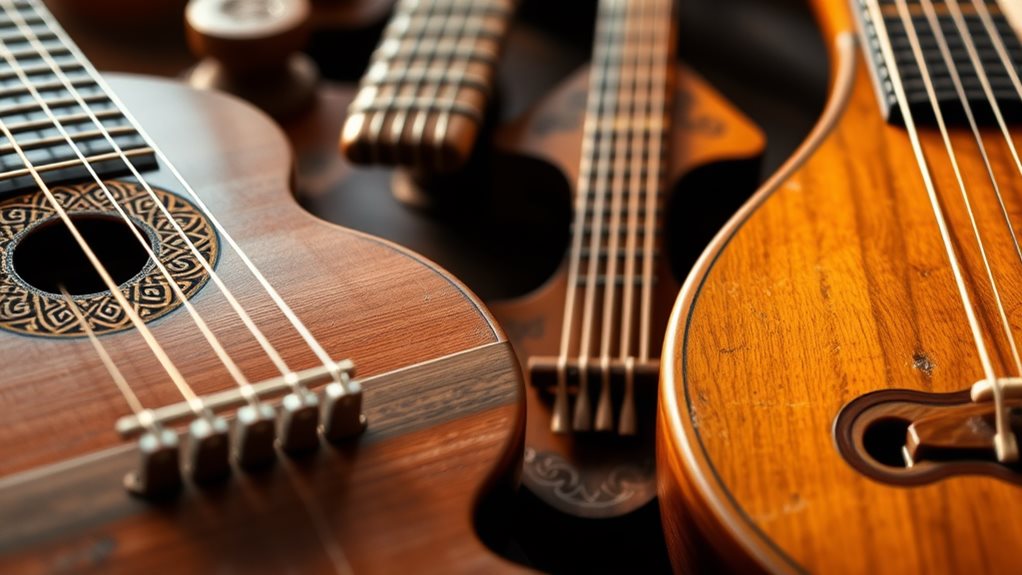
Philippine Stringed Instruments: A Cultural Treasure****
The rich cultural heritage of the Philippines is reflected in its diverse collection of stringed instruments, each with its unique cultural identity and historical influence.
The Kudyapi: A Testament to Filipino Craftsmanship****
The kudyapi, an indigenous instrument from the Philippines, is crafted from a single piece of wood, often jackfruit, carved into a hollow body with a long neck. It typically has one or more strings, traditionally made from animal gut or abaca fibers, but now often nylon or wire.
The kudyapi's cultural significance is immense, showcasing the artistic traditions of the indigenous communities.
Construction and Regional Variations
Artisans skillfully shape the instrument using locally sourced materials, reflecting the unique touch of each regional community.
Playing techniques vary, with some players using fingers and others a plectrum.
Cultural Significance and Uses
The kudyapi is used in various cultural contexts****, including:
- Rituals, social gatherings, and storytelling
- Accompanying love songs, traditionally played by men
- Showcasing Southeast Asian influences in its historical roots
- Preserving indigenous cultural heritage
The Kudyapi's Role in Cultural Performances and Education****
The kudyapi plays a crucial role in cultural performances and ceremonies****, such as weddings and healings.
Its use in educating younger generations ensures the continuation of its legacy. Understanding the kudyapi's construction and historical context highlights its integral place in Philippine music and cultural heritage.
Bamboo Instruments
Bamboo's Versatility in Traditional Philippine Instruments****
Numerous traditional Philippine musical instruments utilize bamboo, showcasing the resourcefulness and artistry of various indigenous communities. These instruments can be classified into three main categories: percussion, wind, and idiophone****.
Percussion Instruments
In the percussion category, there's the bungkaka, a bamboo buzzer; the gabbang, a xylophone; the tongatong, used in Kalinga healing rituals; the kulibaw, a scraper mimicking animal sounds; and the agung a tamlang, a slit drum.
Wind Instruments
Wind instruments demonstrate the versatility of bamboo, with examples like the diwas (or saggeypo) panpipes, the tongali nose flute, the palendag lip-valley flute, the tulali flute, and the bulungudyong vertical flute.
Idiophones
Idiophones, encompassing instruments like the kagul scraper, the gandingan gongs, the kulintang gongs, the luntang beams, and the babandil gong, further illustrate the breadth of bamboo's application.
Cultural Significance of Bamboo
Bamboo holds deep cultural significance in Filipino music. The selection and cutting of bamboo are steeped in traditional techniques, evident in instruments like the kubing jaw harp.
Regional variations are striking, with the gabbang and diwas holding prominent positions in Southern Philippine cultures. Their use in rituals and celebrations underscores their spiritual and cultural value.
This diversity reflects a rich musical heritage, each instrument possessing unique sounds and regional associations. Even today, bamboo instruments remain highly valued, featured prominently in traditional Filipino music performances and festivals, preserving their legacy.
Cultural Syncretism
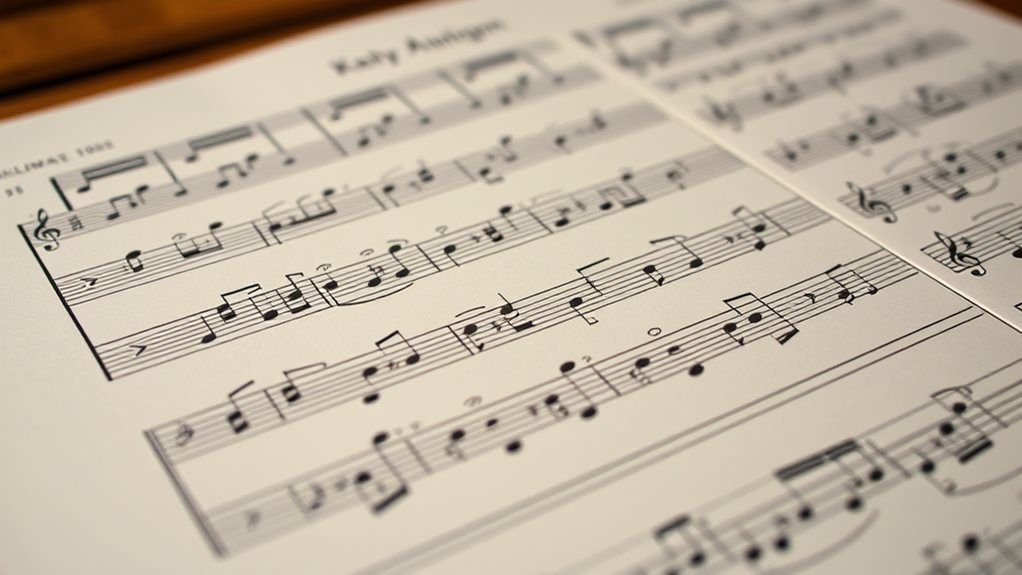
Philippine Music: A Blend of Indigenous and External Influences****
Philippine history is woven with a rich tapestry of musical traditions, reflecting both indigenous artistry and external influences. Cultural syncretism defines Filipino music, a vibrant blend of pre-colonial practices and later introduced traditions.
The Spanish Colonial Period's Impact****
The Spanish colonial period significantly impacted musical forms. For instance, the harana, a courtship serenade, showcases the fusion of indigenous melodies with the Spanish habanera rhythm, highlighting the music's social and ritual significance.
Similarly, the kundiman, a romantic song, seamlessly incorporates Western harmonic structures within a Filipino expressive framework.
Religious Practices and Syncretism
Religious practices further exemplify this syncretism. The subli, a ritualistic song, integrates indigenous spiritual beliefs with Western religious elements, demonstrating the powerful interplay between tradition and adaptation.
Festive Expressions and Cultural Exchange
Festive expressions, too, reflect this unique blend. The sinulog, a vibrant festival, showcases a fusion of pre-colonial and Hispanic influences through music and dance, demonstrating how cultural exchange shapes festive expressions.
Examples of Syncretism in Action
The Pasyon, a narrative chant recounting the life of Christ, retains pre-Hispanic vocal styles within a Christian context.
The zarzuela****, a theatrical form, adapted from Spanish origins, became a distinctly Filipino art form.
The rondalla****, a plucked-string ensemble, exemplifies the successful acculturation of a Western instrument into Filipino musical practice.
Indigenous instruments like the kutiyapi and kulintang continue to play vital roles, maintaining their ritual significance within updated musical contexts.
The Result: A Unique Musical Landscape****
This dynamic interplay between indigenous traditions and external influences has resulted in a unique musical landscape.
Filipino music's strength lies in its ability to adapt and evolve while preserving core elements of its rich cultural heritage.
Western Music Education
Western Music Education: A Historical Overview****
Western music education has its roots in the medieval period, evolving over centuries into the formalized system we know today. The Schola Cantorum and the conservatory system established in the late 18th century played significant roles in shaping music education. The curriculum emphasizes classical music, covering theory, history, instrument training, and ensemble playing****.
Comprehensive Approach to Music Education
A comprehensive approach to music education covers harmony, melody, rhythm, and form, focusing on performance practices across various periods. This approach enables students to understand music from different eras and genres.
Diverse Pedagogical Approaches
Several pedagogical approaches are used in Western music education, each offering unique strategies for developing musical skills. These approaches include:
- Dalcroze Eurhythmics, which focuses on rhythmic movement, ear training, and improvisation to awaken innate musicality.
- Kodály Concept, which emphasizes choral singing and folk music to develop basic skills and music literacy.
- Orff-Schulwerk, which stresses play, iconic percussion, and improvisation to encourage exploration and composition.
- Suzuki Method, which prioritizes early-age learning and parental involvement to foster a supportive learning environment.
Contemporary Practices and Inclusive Curricula
Contemporary Western music education practices have broadened to incorporate diverse musical styles and inclusive curricula.
There's an increasing emphasis on community engagement and non-formal approaches, reflecting a shift towards more inclusive and relevant music education. This evolution continues to shape curriculum development and pedagogical approaches within the field.
American Period Influence
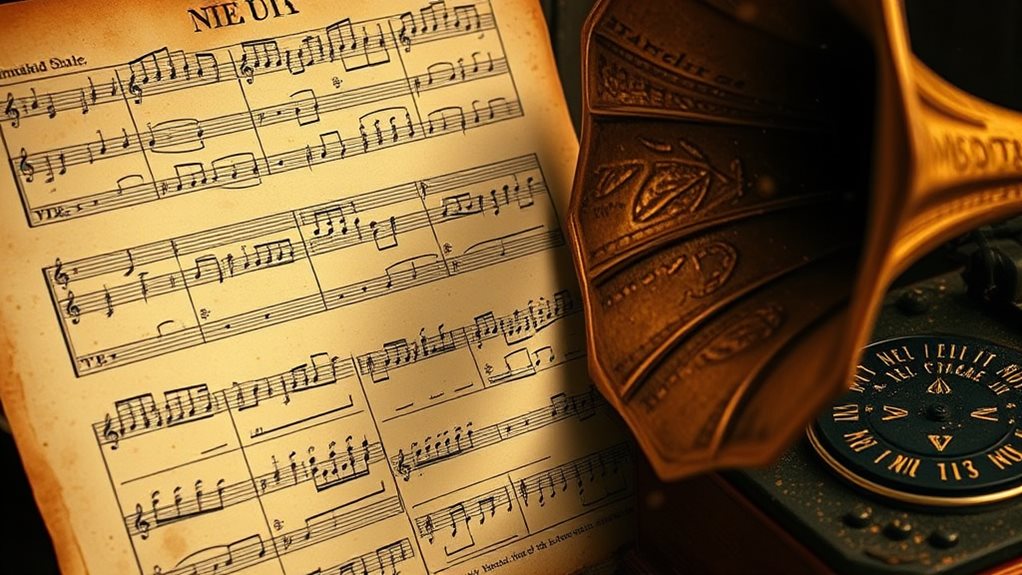
The American colonial period significantly impacted Philippine music, introducing new genres and influencing existing forms.
During this time, new musical styles such as blues, folk, R&B, and rock and roll were introduced, leading to the fusion of Afro-American and Hispano-Filipino musical styles. For example, jazz emerged, and Filipino talents like Luis Borromeo and Francisco Santiago showcased their skills.
Western classical music also flourished, enriching the Philippine musical landscape.
The zarzuela, a Spanish theatrical form, underwent adaptation and localization. However, it faced censorship under American rule. Traditional Filipino music absorbed influences from American blues and jazz, resulting in genres like Pinoy jazz.
The banda tradition continued, highlighting the enduring power of Filipino musical traditions. Brass bands, promoted by the Americans, became a symbol of "civilization."
American narratives often minimized the pre-existing musical sophistication of the Philippines. They portrayed Filipinos as musical novices needing colonial tutelage. The Philippine Constabulary Band's performance at the 1904 St. Louis World's Fair exemplified this biased portrayal.
However, Filipino musicians actively resisted this framing.
Nationalist sentiments found expression in music, challenging colonial narratives. For instance, the use of Taglish in songs reflects the cultural hybridity of this era.
Filipino musicians creatively blended indigenous styles with Western influences. The American period resulted in a rich tapestry of musical styles, showcasing both continuity and change.
This period's legacy is one of complex cultural hybridity. It's characterized by resistance and adaptation intertwined within the context of music colonialism.
The resulting musical landscape reflects both the imposition of foreign musical styles and the enduring strength of Filipino musical traditions.
Modern Filipino Music
Modern Filipino Music: A Blend of Cultural Identity and Globalization****
Modern Filipino music is built upon the complex legacy of the American colonial period, absorbing and adapting diverse influences while forging unique national sounds. The Manila Sound, emerging in the mid-1970s, is a pivotal influence, blending Tagalog and English – "Taglish" – into rock music, paving the way for future genre fusion. Bands like Juan Dela Cruz and Hotdog pioneered this sound, shaping modern Filipino musical themes.
Pinoy Pop (P-pop) is a significant contemporary style, rising to prominence in the 2010s. It reflects the country's rapid economic and cultural growth**, incorporating elements from K-pop and J-pop while emphasizing Asian identity. Artists like Regine Velasquez and SB19 represent this evolution, showcasing a higher production value** and a shift away from Western genre dominance.
Musical Themes in modern Filipino music often retain a focus on love and sentimentality, expressing deep emotional longing similar to the kundiman's poetic expressions.
However, there's a move towards lyrical simplicity in some instances, making the expression of feelings more direct.
Traditional instruments still find their place, but modern instruments, including synthesizers and electronic sounds, are now integral parts of the musical landscape.
The incorporation of these elements, alongside greater use of percussion and brass instruments, contributes to the evolving sound of the nation, reflecting a complex interplay between cultural identity and globalization.
Questions and Answers
How Does Filipino Music Theory Differ From Western Theory?
Filipino music theory diverges from Western theory in several key aspects. It combines indigenous and foreign influences, resulting in a unique blend of cultural styles. For instance, traditional Filipino instruments like the kulintang and agung are often played alongside Western instruments, creating a distinct sound. It emphasizes oral tradition and improvisation, prioritizing the passing down of musical knowledge through generations over written notation. This approach allows for greater creative freedom and adaptability, as musicians can modify and improvise melodies and rhythms in real-time.
What Are the Unique Rhythmic Patterns in Filipino Music?
Filipino music is characterized by polyrhythmic structures. These complex rhythmic patterns often incorporate indigenous influences, adding a unique flavor to the music. Complex layered rhythms, syncopation, and triplet rhythms are prevalent, creating a rich and dynamic sound.
Are There Specific Scales Used in Traditional Filipino Music?
Traditional Filipino music often employs specific scales.
Pentatonic scales are frequently used, particularly in kulintang music. Kulintang is a traditional instrumental form of music and dance from the Southern Philippines, and it typically features a five-note scale pattern.
Regional variations also exist, with five- or six-tone scales being used in different parts of the country. These regional scales contribute to the rich diversity of traditional Filipino music.
Diatonic scales are common in Christianized music, which reflects the influence of Western music on Filipino culture. Diatonic scales are commonly used in Western music and were introduced to the Philippines through Christianization.
How Is Improvisation Used in Filipino Musical Traditions?
Improvisation is a core element in Filipino musical traditions, highlighting its cultural importance. In the Kulintang tradition, improvisation is used to create complex rhythmic modes, showcasing the adaptability of this ancient gong-based music. Similarly, in vocal epics, improvisation allows storytellers to weave intricate narratives, reflecting regional variations and cultural diversity.
What Are the Typical Melodic Contours of Filipino Songs?
Filipino songs exhibit diverse melodic contours, reflecting the country's rich cultural heritage.
Indigenous traditions are characterized by polyrhythms, where multiple rhythms are played simultaneously, and ornamentation, which involves elaborate and intricate melodic decorations. For example, the Maguindanao and T'boli tribes of Mindanao are known for their complex polyrhythms in their traditional music.
Spanish-influenced styles, on the other hand, feature Western harmonic structures, which are evident in the use of chords and melody lines that follow Western musical conventions. The traditional Filipino song " Kundiman", for instance, showcases a mix of Spanish and Filipino musical elements, with its soaring melody lines and harmonies reminiscent of Western music.